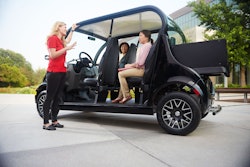
Most organizations, 86 percent, according to recent IBV research, have a sustainability strategy in place, but only 35 percent have acted on that strategy. Electric vehicle (EV) usage has also exploded from where it was a decade ago, but many businesses are still hesitant to make the switch. EVs are having more than just a moment; they are here for the long haul. And today, it is easier than ever for organizations across industries to electrify their fleets.
Here's a breakdown and debunking or the most common concerns around electric vehicles, so operations can confidently jumpstart their commitment to sustainability beginning with fleets.
Cost: Can you afford to make an upgrade?
Vehicles are assets. With the current average light vehicle age of 12.2 years, it is an important purchase decision. As gas vehicles begin to reach the end of their useful lives, making the transition to electric fleets could provide significant savings. In fact, a recent survey of fleets in 10 of Arizona’s largest municipalities found that those ten cities could save a total of nearly $80 million in lifetime vehicle ownership costs just by replacing light-duty vehicles in their fleets with commercial EVs.
While gas costs vary state-to-state and mileage varies by vehicle make and model, according to the Environmental Protection Agency (EPA), the average car got just under 26 miles to the gallon in 2021, putting the cost to operate at about $0.13/mile based on today’s national average gas price of $3.50/gallon. Comparatively, the efficiency of EVs will depend on price of electricity and kWh used per 100 miles for the specific EV. For example, with the current price of electricity in the United States at an average of 16.8 cents per kWh, if the EV consumes 27 kWh to travel 100 miles, the cost per mile is about $0.05/mile. With gas prices typically more volatile than electric prices, operations can also more confidently budget total cost to operate an electric fleet.
When factoring in average maintenance, repair and taxes along with yearly driving and idling time into the overall operational costs, EVs are low total cost vehicles to own and operate. With fewer moving parts than an internal combustion engine, EVs require far less maintenance. For operations, this means increased uptime and profits.
To help operations make the transition, many states, municipalities and utilities offer commercial entities incentives (rebates, grants and tax credits) to acquire EVs. In addition, the Inflation Reduction Act provides a tax credit to offset the cost of certain qualified commercial clean vehicles placed in service before 2033.
Range anxiety: Can you get the job done?
Across industries, time is money. And that means relying on electric vehicles that are ready to move when you are. Vehicle range will always fluctuate based on factors such as payload, climate and driving conditions, but depending on vehicle model, the ranges of today’s commercial EVs are less of a concern, especially when deployed in the right applications. Most organizations do not need hundreds of miles; 40 to 60 miles of range between charges is more than sufficient to get the job done.
Logistics companies making cross-state and city deliveries will need vehicles with substantial range and high speeds. However, for last-mile applications, right-sized, right-speed low-speed vehicles (LSVs) may be the best solution for local deliveries. On congested, traffic-controlled streets, LSVs travel across town just as quickly as a standard vehicle. They have become the vehicle of choice for many municipalities, corporations, colleges and universities looking for small scale, sustainable vehicles.
For municipalities, warehouses, tarmacs and industrial parks that require considerable towing and hauling, a traditional full-size internal combustion (ICE) truck or tow tractor also is not the only option. Electric utility vehicles, burden carriers and tow tractors have towing and hauling comparable to these ICE alternatives, but without the carbon emissions, and with smaller dimensions to fit through tight corridors and narrow aisles.
Additionally, battery options provide greater flexibility for vehicle distance. They have lithium-ion battery packs that provide upward of 95 miles of range between charges. Incorporating solar panels will further extend vehicle range by adding 2 miles of charge per hour while vehicles are in direct sunlight.
Infrastructure: Are you ready to go electric?
One of the largest barriers to going electric is charging access and infrastructure updates. The good news is infrastructure changes may not be necessary. While full-size highway commercial vehicles may need additional charging capabilities, many other operations and municipalities can charge commercial vehicles sufficiently overnight through standard 120– or 110-volt AC outlets, with many industrial vehicles using the same charging infrastructure.
Some vehicles use the same charging infrastructure as electric cars, while others have an on-board charger that plugs into a 110V wall outlet, the same used for a smartphone. For operations requiring greater charging capabilities such as fast charging, additional options are available. Many states and counties provide charging infrastructure incentives that include rebates, technical support and even free or discounted charging stations.
With heightened environmental concerns and a growing desire for cleaner mobility, demand for EVs has grown exponentially over the past decade and has no signs of slowing down. And with an increase in vehicle options available, greater accessibility and financial incentives, going electric is one sustainable goal that consumers, businesses, and municipalities can check off with confidence.



















![U8kj71gt 720[1]](https://img.greenindustrypros.com/mindful/acbm/workspaces/default/uploads/2025/10/u8kj71gt-7201.8OyDyc124u.jpg?ar=16%3A9&auto=format%2Ccompress&fit=crop&h=135&q=70&w=240)
